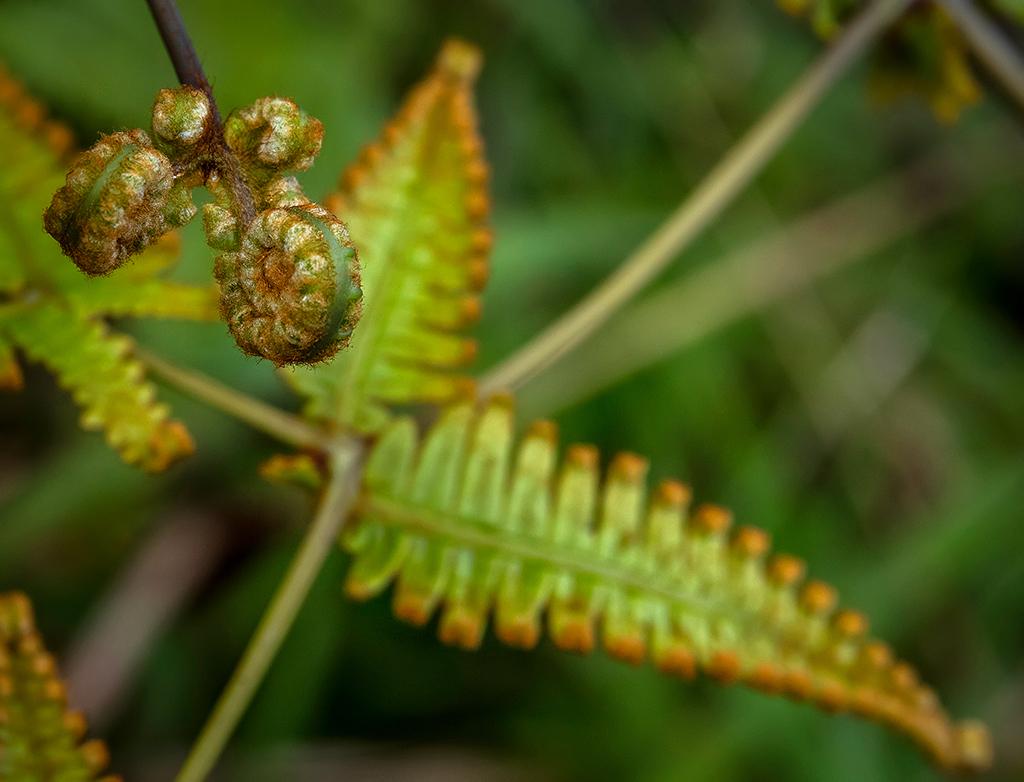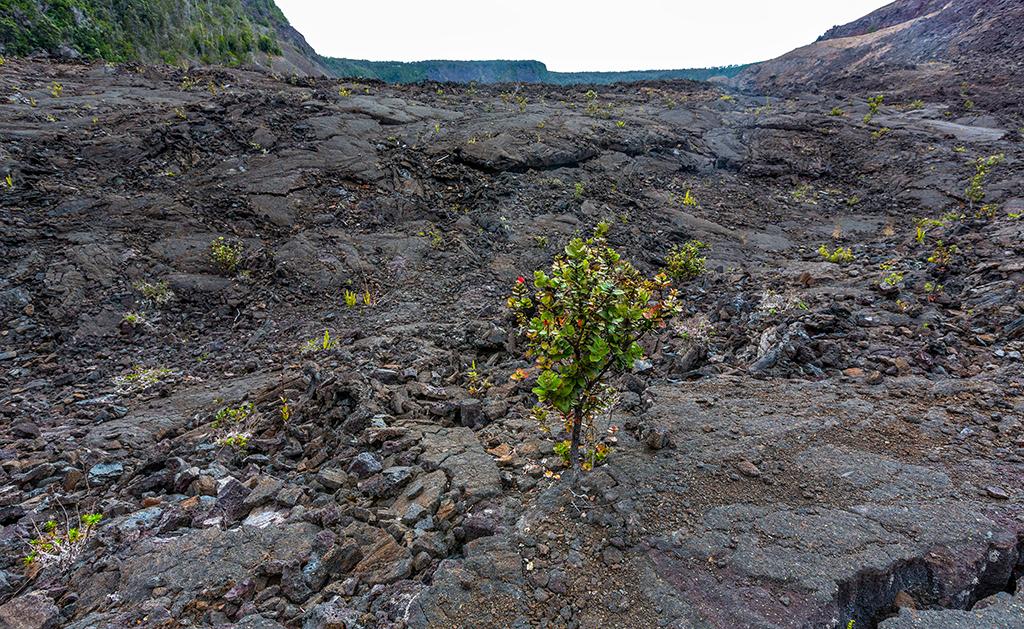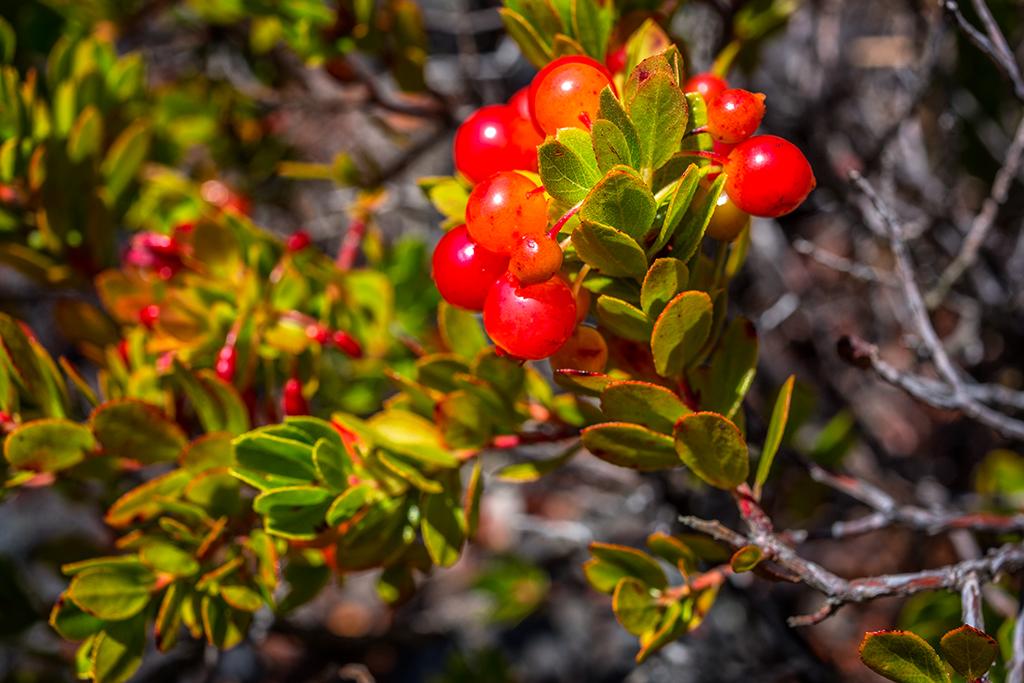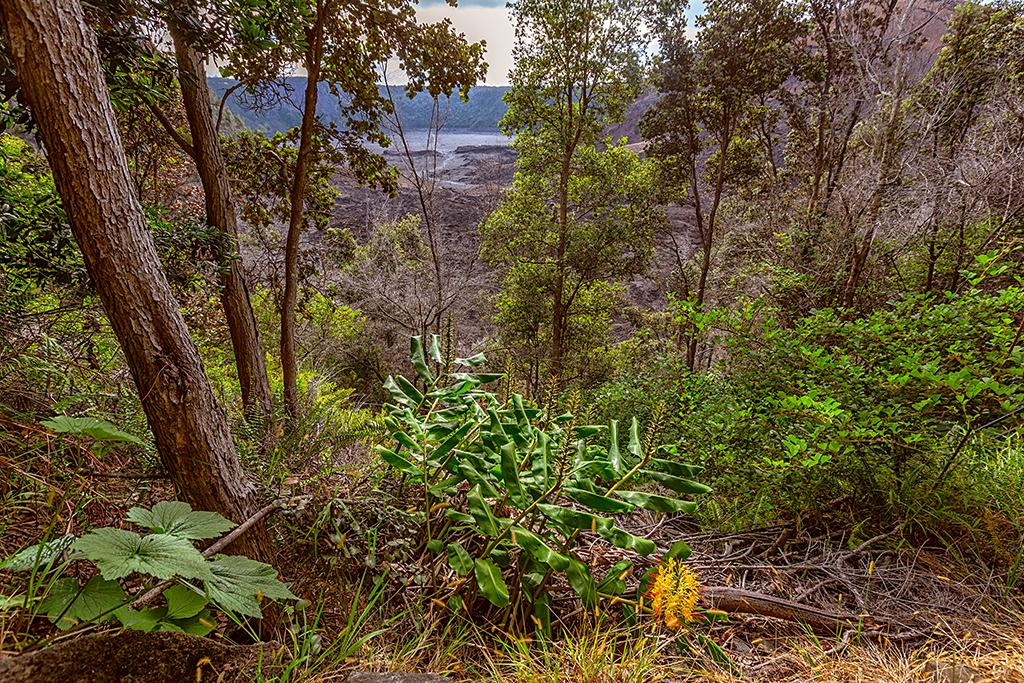The Hawaiian Islands are isolated, sitting as they do in the Pacific Ocean, away from anything other than an airplane or boat that might link these hot spot remnants to the Mainland. As such, many of the plants and trees you see during a visit to Hawai’i Volcanoes National Park, you won’t see anywhere else.
Below is a very small sample of plants and trees you will probably see during your visit to this national park. To read about more species, and in greater detail, click on the links.

Furled and unfurled, the uluhe (aka false staghorn) fern, Hawai'i Volcanoes National Park / Rebecca Latson
One of the first things to strike your vision will be the bright greens of the many ferns waving in the tropical breeze everywhere you look once you set foot on Hawai’i. The National Park Service calls ferns “icons of the Hawaiian rainforest,” but you’ll see these bright green plants popping up from cracks between the cooled rocky or ropy lava flows along your hikes over desolate lava fields, in addition to those ferns carpeting the rainforest floors.
Hawai’i Volcanoes staff say:
Arriving as spores carried on the wind, ferns were among the first vascular plants to colonize the young Hawaiian Islands when they were newly formed. About 200 species of ferns can now be found across the entire island chain. Sixty-five percent of these species are considered endemic, found nowhere else in the world.
Ferns are usually the first to colonize recent lava flows. If you hike the Kīlauea Iki trail, you’ll see ʻamaʻu ferns growing all by themselves in between clinkery ‘a‘ā flows.
All along the park’s floors, you’ll also view the feathery fronds of palapalai and uluhe (aka false staghorn) ferns.

A solitary ʻamaʻu fern along the Kīlauea Iki trail, Hawai'i Volcanoes National Park / Rebecca Latson
Among the unique tree species growing in the park, you’ll probably spot two icons of Hawai’i.

A blooming ʻōhiʻa lehua tree along the Kīlauea Iki trail, Hawai'i Volcanoes National Park / Rebecca Latson
When you spot your first plumy, bright orange ʻōhiʻa lehua bloom, you might see it from a knee-level “bush.” But the ʻōhiʻa lehua is a tree, of which there are eight varieties of this native Hawaiian tree, four species of which are found in Hawaiʻi Volcanoes National Park. You might see this tree and it’s bright blossoms during your hike along the Kīlauea Iki trail as well as elsewhere within the park.

A bright red ʻōhiʻa lehua bloom, Hawai'i Volcanoes National Park / Rebecca Latson
In recent years, this iconic tree has been threatened by ROD (Rapid ʻŌhiʻa Death), a fungal disease that’s been attacking and killing the trees on Hawai’i Island.
Hawai’i Volcanoes staff say:
ʻŌhiʻa is the keystone species in Hawaiian forests, and ROD has the potential to cause major ecosystem disturbances that will negatively impact watersheds, cultural traditions, natural resources, and quality of life.
Infected ‘ōhi‘a trees may have individual branches or entire canopies of recently dead and still attached brown leaves. The tree's sapwood may have dark and unusual staining and a fruity odor, though signs of the fungus may not be visible on the outside of the tree. Additional testing is needed to confirm ROD, since ‘ōhi‘a may also die from other diseases, drought and injury.
The Koa tree is a keystone species in some ecosystems and forests of them may be found around the Mauna Loa section of the park. Their wood is prized in creating the wooden hulls of canoes and other items. Koas can grow as tall as 100 feet (30m).
Just as the trees and ferns are iconic and unique, so are Hawai’i Volcanoe’s shrubs and bushes.
You may have read about the silversword plants at Haleakala National Park, on the Hawaiian island of Maui. But, did you know that there is a silversword plant that survives only on the flanks of Mauna Loa? The ʻĀhinahina (Mauna Loa Silverswords) are lessor known than their other two counterparts growing on Mauna Kea and at Haleakala National Park.
There are two silversword plants which grow on Mauna Loa: the Kaʻū and the Waiākea.
According to park staff:
The Mauna Loa silversword plants generally grow fewer "petals" in their flowerheads and their thinner leaves are less hairy. Also remarkable is their life history. It is only once in their lives and only after 10 to 30 years that 'āhinahina send up a spectacular stalk of fragrant flowers as tall as 9 feet (3 meters). Within weeks it goes to seed and its life is concluded—the entire plant dies.
As you wander the cracked lava fields along the Chain of Craters Road, or hike the Mauna Ulu trail, you might come across a small, low-growing shrub laden with bright orange-red berries. This is the ʻōhelo plant, and those sweet-tart berries have history as well as importance as a food source for the nēnē.

‘Ōhelo berries, an important food source for the nēnē and a tasty ingredient for jams, Hawai'i Volcanoes National Park / Rebecca Latson
Park staff say:
Because of the dependence by the nēnē on the fruit, it is asked that people do not gather the berries in the park. There are also two species of moths found nowhere else in the world that live exclusively in ʻōhelo berries during their larval stage.
As a pioneer species, it [the ʻōhelo] is one of the first plants to colonize new lava flows. The plant is also famously considered sacred to Pele, the Hawaiian volcano deity. In Native Hawaiian custom, it is proper to offer ʻōhelo berries to Pele before consuming any oneself. In her storied excursion to Kīlauea in 1824, Chiefess Kapiʻolani famously renounced Pele on the rim of Halemaʻumaʻu crater by eating ʻōhelo berries without an offering to the fiery deity first.
There are two species of ʻōhelo within Hawai’i Volcanoes National Park, the common ʻōhelo, as well as ʻōhelo kau la’au, also known as tree ʻōhelo.
Invasive plants, like invasive animals, may be beautiful, or fragrant, or even delicious, but they edge out the native species of Hawai’I and, in some cases, create fire hazards during periods of dry weather or drought. For instance, while hiking through the rainforest before stepping out upon the solidified lake of the Kīlauea Iki trail, you might notice the beautiful, bright yellow Himalayan ginger (Hedychium gardnerianum), aka Kāhili ginger because it resembles the feathered staffs of Hawaiian royalty. This inedible ginger plant was brought to the islands as an ornamental plant, and the dense root mats of this invasive plant dominate the forest understory, hindering the growth of other understory species, such as ferns, and the regeneration of native trees.

Another ornamental species originating from Africa is fountain grass, which grows in three-foot-tall clumps, has rolled leaves, and is topped with 4-10 inch red-purple flower spikes. It is dispersed by wind and mostly found in dry areas such as fresh lava flows, rangelands, and the roadsides of Kona. This grass is highly flammable, has outcompeted the native grasses, and now covers 200,000 acres (80,937 hectares) of land on the Kona side of the Big Island.
Strawberry guava is considered quite delicious, but is one of the worst invasive species in Hawaiʻi.
According to park staff:
Native to Brazil, the species [strawberry guava] was likely introduced to the islands in 1825. Since then, it has taken over large swaths of native forest and according to the US Forest Service is capable of invading half the land area on Hawaiʻi Island. Once it is fully established in an ecosystem, it can form dense thickets that crowd out native plants and disrupt the flow of water, both of which in turn have an effect on animals. Compared to healthy native forests, forests invaded by strawberry guava lose over one quarter more water to the atmosphere, according to the Forest Service.





